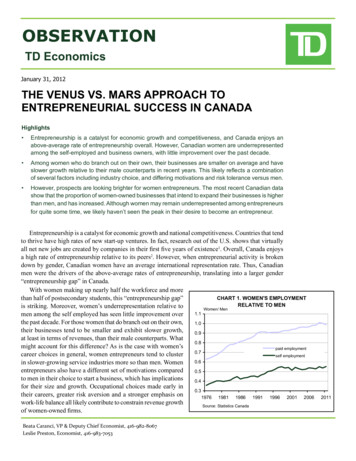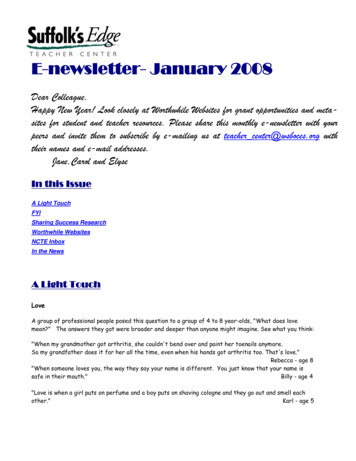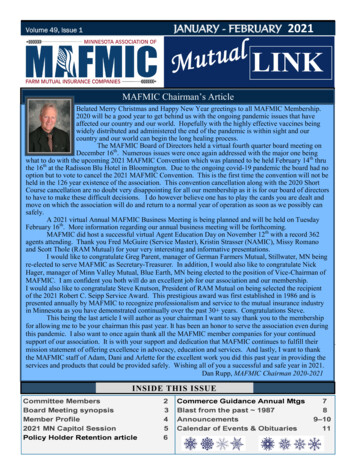
Transcription
OBSERVATIONTD EconomicsJanuary 31, 2012THE VENUS VS. MARS APPROACH TOENTREPRENEURIAL SUCCESS IN CANADAHighlights Entrepreneurship is a catalyst for economic growth and competitiveness, and Canada enjoys anabove-average rate of entrepreneurship overall. However, Canadian women are underrepresentedamong the self-employed and business owners, with little improvement over the past decade. Among women who do branch out on their own, their businesses are smaller on average and haveslower growth relative to their male counterparts in recent years. This likely reflects a combinationof several factors including industry choice, and differing motivations and risk tolerance versus men. However, prospects are looking brighter for women entrepreneurs. The most recent Canadian datashow that the proportion of women-owned businesses that intend to expand their businesses is higherthan men, and has increased. Although women may remain underrepresented among entrepreneursfor quite some time, we likely haven’t seen the peak in their desire to become an entrepreneur.Entrepreneurship is a catalyst for economic growth and national competitiveness. Countries that tendto thrive have high rates of new start-up ventures. In fact, research out of the U.S. shows that virtuallyall net new jobs are created by companies in their first five years of existence1. Overall, Canada enjoysa high rate of entrepreneurship relative to its peers2. However, when entrepreneurial activity is brokendown by gender, Canadian women have an average international representation rate. Thus, Canadianmen were the drivers of the above-average rates of entrepreneurship, translating into a larger gender“entrepreneurship gap” in Canada.With women making up nearly half the workforce and moreCHART 1. WOMEN'S EMPLOYMENTthan half of postsecondary students, this “entrepreneurship gap”RELATIVE TO MENis striking. Moreover, women’s underrepresentation relative toWomen/ Men1.1men among the self employed has seen little improvement overthe past decade. For those women that do branch out on their own,1.0their businesses tend to be smaller and exhibit slower growth,0.9at least in terms of revenues, than their male counterparts. What0.8might account for this difference? As is the case with women’spaid employment0.7career choices in general, women entrepreneurs tend to clusterself employment0.6in slower-growing service industries more so than men. Womenentrepreneurs also have a different set of motivations compared0.5to men in their choice to start a business, which has implications0.4for their size and growth. Occupational choices made early in0.3their careers, greater risk aversion and a stronger emphasis on1976 1981 1986 1991 1996 2001 2006work-life balance all likely contribute to constrain revenue growthSource: Statistics Canadaof women-owned firms.Beata Caranci, VP & Deputy Chief Economist, 416-982-8067Leslie Preston, Economist, 416-983-70532011
TD Economics www.td.com/economicsWomen-Owned SMEs Smaller, But Keen to GrowAccording to Industry Canada’s Survey on Financing ofSmall and Medium Sized Enterprises (SME) survey data,average revenues for majority male-owned businesses weretwice as high as majority female-owned ones, and thisdisparity has grown over time3. While a similar percentage of male and female-owned businesses (41% versus39% respectively) indicated they intended to expand theirbusinesses in the 2004 survey, male-owned revenues grewby 6.7% while female-owned revenues grew 3.9% overthe following four years. There are various compositionaldifferences that may account for this, including the ageand industry of the business, as well as the experience andgrowth intentions of the owner.For starters, women-owned businesses are younger onaverage and their owners have fewer years of managementor ownership experience relative to male-owned firms.Women are also far more likely than men to run businessesin the slower-growing and more labour-intensive servicesindustry. By extension, men are more likely to run busineses in the more cyclical goods sector, which would havestronger growth during good times, but contract more during recessions. For example, the number one industry forself-employed women in Canada is health care and socialassistance; for men it’s construction. Clustering of womenentrepreneurs in services industries also helps explain whyamong growth-oriented firms, those led by women grewtheir staff by 7.6% in the subsequent four years comparedto 1.4% for men.Aside from industry choice, it appears that at least partof the gender disparity in revenues is by design. AlthoughCHART 2. FEMALE VS. MALE-OWNED FIRMSFINANCIAL "GAPS"600500Men's average - Women's average ( , Thousands)RevenueAssetProfit*400CHART 3. BUSINESS TENURE & OWNER'SEXPERIENCE1001000200020042007*Average net profits before tax (not statistically significant difference in '04 & '97)Source: SME Financing Data Initiative, Statistics Canada, Suvery on Financing of Smalland Medium Enterprises , 2007.January 31, 2012Female owned80Male owned6040200Business 6 yrs oldOwner 10 yrsmanagement/ownershipexperienceSource: SME Financing Data Initiative, Statistics Canada, Suvery on Financing of Smalland Medium Enterprises , 2007.studies show that women are equally likely to seek and attainfinancing relative to men, there is some evidence suggesting that they may not be seeking enough financing to growtheir businesses. An American study4 showed that womenentrepreneurs raised less start-up capital for their ventures,and this carried through to raising less incremental financing in subsequent years. The end result being that womenhad less financial capital invested in their businesses thanmen, on average, after controlling for variables such as age,ethnicity, and education. This financing gap versus men hasimplications for growth, since the amount of financing raisedcan affect a firm’s ability to expand and increase revenuegrowth. The American results seem to fit with the outcomesobserved on the Canadian front. The median debt-to-equityratio for Canadian male-owned firms was higher in both2004 and 2007, suggesting that male-owned firms were moreaggressive in financing firm growth through debt.The question that naturally comes to mind is why wouldwomen intentionally seek less financing? This is wheremotivations for starting a business comes into play.Canadian research into the motivations of male andfemale entrepreneurs5 categorized them into three groups: classic: motivated by pull factors, such as independence,desire to be one’s own boss, earn more money, challengeor creativity (71% of men, 53% of women) forced: enters entrepreneurship due to a lack of otheralternatives (22% both men and women) work-family: entrepreneurship fulfills a desire towardsgreater work-life balance (25% of women, 7% of men)300200PercentThe one quarter of women entrepreneurs who opted to2
TD Economics www.td.com/economicsrun their own business out of a desire for greater balancebetween work and family are likely to pursue less aggressive growth strategies. There is evidence that this is indeedthe case.While male and female entrepreneurs were equally likelyto desire business growth, there are important differences inhow they wish to do so6. Female entrepreneurs seem to set amaximum threshold size for their businesses, beyond whichthey are not interested in growing, and these thresholds arelower than their male counterparts. Female entrepreneursalso tend to be more concerned about the risks associatedwith fast-paced growth, deliberately choosing to expand ina controlled and manageable manner. This implies that evenmany “classicly” motivated women entrepreneurs pursuegrowth less aggressively than their male counterparts.Not surprisingly the different gender motivations matterfor income, with classic entrepreneurs having much higherincome levels7. And, women who have become entrepreneurs for reasons of work-family balance may be less likelyto pursue aggressive growth strategies that would requiresignificant investments of time into the business. One example of a growth-limiting strategy by women entrepreneursis a lower propensity to pursue exporting. Male-ownedbusinesses have a significantly greater tendency to export,even after controlling for sector, firm and owner attributes8.Exporting enables businesses to access a much larger marketfor their products or services, enhancing the revenue growthpotential, an opportunity that women entrepreneurs have sofar been less likely to take advantage of.Motivations also influence decision to become anentrepreneurWhile motivations help explain business performanceamong the genders, it also offers some insight as to whyfewer women are drawn to entrepreneurship in the firstplace. The “classic” motivation is less represented amongwomen because paid employment often offers a bettervalue proposition. The price of greater independence andincome potential in self employment is greater risk, whichis manifested through greater variability of earnings relativeto waged employment. Study after study shows that menare more responsive to the expected (and potential) earnings differentials between wage and self employment thanfemales, whereas women are more risk averse9. That greaterrisk aversion influences women’s choices early on in theircareers. A Canadian study10 which surveyed enrolment inundergraduate entrepreneurship courses (in various disciplines) found that female enrolment is far lower than male.January 31, 2012CHART 4. SELF EMPLOYMENT BY INDUSTRY1750Thousands of self-employed15001250Services, 11481000750500Services, 844Goods, 5752500Goods, 106WomenMenSource: Statistics CanadaNot only is the “classic” entrepreneurship pull lessstrong for women, but paid employment has been quite attractive for women in recent years. Wages for women aged25-54 have increased 13% in real terms from 2001-2011,compared to only 5% for men, thus narrowing the genderhourly wage gap among paid-employment11. This may beone among many reasons why self-employed women relative to men have made little progress in the last 10 years(see Chart 1), whereas in paid employment women increasedtheir representation by 8 percentage points relative to men.Paid employment has also likely become more attractive forwomen through increased availability of flexible workingarrangements like telecommuting and flex-time, which helpbalance work and family commitments.The “classic” entrepreneurial motivation also encompasses some unique challenges for women, especially forthose who want to start families or have young children.Entrepreneurship typically entails putting in long hours toensure the success of your business, with 40% of the selfemployed putting in more than 50 hours per week in 2010,compared to only 5% of paid employees. These typicallylonger hours make entrepreneurship less feasible for manywomen, particularly those with young children. Self-employment can also mean forgoing or paying more for manybenefits that come with being an employee, like pensions andhealth benefits, and, until recently, access to employer-paidand maternity leave benefits were restricted under EI. Ofnote, a study of 168 self-employed women across Canadain a variety of occupations revealed that most women haddifficulty taking time off from their business for maternity/parental, sickness or family care due to difficulty in finding3
TD Economics www.td.com/economicsa replacement, reduced earnings or loss of client and visibility12. The most recent report conducted by Statistics Canada(2004) showed that 1-in-3 self-employed women returnedto work within two months of having a child, compared to5% of paid workers13.Brighter Prospects AheadSince the decision to start a business is often rooted indifferent motivations for men and women, it’s not all together surprising that different outcomes are generated inattracting entrepreneurs and driving revenues. In regards tothe latter, there are interesting findings that women’s lowerrisk-taking behaviour does not impact profitability. Averagenet profit before tax of female-owned businesses was 89%of male-owned businesses in 2007, a difference that is notstatistically significant, and is an improvement from beingonly 52% of male profits in 2000. Thus, women-ownedSMEs have effectively closed the profit gap with men (seeChart 2). So, even though both genders have approachedentrepreneurship under different agendas (classic vs workfamily) women entrepreneurs are no less savvy in managingtheir businesses.Some factors surrounding women’s decisions that drivethe gender entrepreneurship gap are not likely to change toany great degree in the near future. These include a greaterdegree of risk aversion and disproportionate family responsibilities. However, in terms of educational attainment, futurewomen entrepreneurs are already very different from theirmothers. When today’s business owners were just startingout in 1990, only 43% of young women (25-34) had a postsecondary degree or diploma, slightly less than men. Todaythat number is 71% and ten percentage points higher thanmen. Research shows that entrepreneurs who are motivatedby “classic” reasons are more likely to have a universitydegree than “work-family” entrepreneurs14. While increasededucational attainment isn’t likely to be the cause of “classic” entrepreneurship it does deepen the talent pool availableto start tomorrow’s business ventures.Even in the near term, the prospects for women entrepreneurs are looking brighter. In the most recent SME survey,the percentage of female-owned businesses intending toexpand increased over the previous period and was higherthan the percentage of male-owned businesses (44% versus38%). Women-owned businesses have also increased theirwillingness to seek financing and improved their attainmentrates, which bodes well for future growth. Although womenmay remain underrepresented among entrepreneurs for quitesome time, we likely haven’t seen the peak in their desire tobecome an entrepreneur.Beata CaranciVP & Deputy Chief Economist416-982-8067Leslie Preston, Economist416-983-7053January 31, 20124
TD Economics www.td.com/economicsEndnotes1Mitchell, Lesa, “Overcoming the Gender gap: Women Entrepreneurs as Economic Drivers.” Ewing Marion Kauffman Foundation, September 2011.2Among a group of 21 high-income, low-growth countries which include: Australia, Belgium, Denmark, Finland, France, Germany, Greece, Iceland,Ireland, Italy, Japan, Netherlands, New Zealand, Norway, Singapore, Spain, Sweden, UK, US, Switzerland, Austria.3Jung, Owen, “Small Business Financing Profiles, Women Entrepreneurs” Small Business and Industry Branch, Industry Canada, October 20104Coleman, Susan and Alicia Robb, “A comparison of new firm financing by gender: evidence from the Kaufmann Firm Survey data,” Small BusinessEconomics, 33, p. 397-411, 2009.5Karen D. Hughes, “Exploring Motivation and Success Among Canadian Women Entrepreneurs”, Journal of Small Business and Entrepreneurship19(2), 2006.6Cliff, J.E., “Does one size fit all? Exploring the relationship between attitudes towards growth, gender, and business size”. Journal of BusinessVenturing, 13: 523-542, 1998.7Karen D. Hughes, “Exploring Motivation and Success Among Canadian Women Entrepreneurs”, Journal of Small Business and Entrepreneurship19(2), 2006.8Orser, B., Spence, M., Riding, A. and Carrington, C. A., “Gender and Export Propensity,” Entrepreneurship Theory and Practice, 34: 933–957, 2010.9Le Maire, Daniel and Schjerning, Bertel, “Earnings, Uncertainty and the Self-Employment Choice” Discussion Paper, Centre for Economic andBusiness Research, April 2007.10 Menzies, Teresa V and Tatroff, Heather, “The Propensity of Male Vs. Female Students to Take Courses and Degree Concentrations in Entrepreneurship,” Journal of Small Business and Entrepreneurship, Vol. 19, Issue 2, p. 203-218, 2006.11 Drolet, Marie, “Why has the gender wage gap narrowed?” Perspectives on Labour and Income. Vol. 23, no. 1. Statistics Canada Catalogue no. 75001-XIE, 2011.12 Jennifer Rooney, Donna Lero, Karen Korabik and Denise L. Whitehead with Mona Abbondanza, Jocelyne Tougas, Jane Boyd and Lise Bourque,“Self-Employment for Women: Policy Options that Promote Equality and Economic Opportunities .” University of Guelph, Centre for Families,Work and Well-Being, November 2003.13 Canada, Statistics Canada. 2004. “Employment Insurance Coverage Survey 2002.” The Daily. January 14. Ottawa.14 Karen D. Hughes, “Exploring Motivation and Success Among Canadian Women Entrepreneurs”, Journal of Small Business and Entrepreneurship19(2), 2006.This report is provided by TD Economics. It is for information purposes only and may not be appropriate for other purposes. The reportdoes not provide material information about the business and affairs of TD Bank Group and the members of TD Economics are notspokespersons for TD Bank Group with respect to its business and affairs. The information contained in this report has been drawn fromsources believed to be reliable, but is not guaranteed to be accurate or complete. The report contains economic analysis and views,including about future economic and financial markets performance. These are based on certain assumptions and other factors, and aresubject to inherent risks and uncertainties. The actual outcome may be materially different. The Toronto-Dominion Bank and its affiliatesand related entities that comprise TD Bank Group are not liable for any errors or omissions in the information, analysis or views containedin this report, or for any loss or damage suffered.January 31, 20125
to men in their choice to start a business, which has implications for their size and growth. Occupational choices made early in their careers, greater risk aversion and a stronger emphasis on work-life balance all likely contribute to constrain revenue growth of women-owned firms. THE VENUS VS. MA











